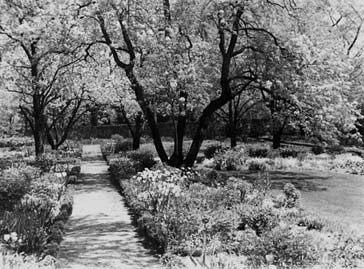
Ellwanger Garden
Rochester, New York
Pear Trees Rochester, New York

Courtesy The Landmark Society of Western New York
history continued
George Ellwanger passed away in 1906, shortly before his ninetieth birthday. The Ellwanger and Barry Nurseries ceased operations in 1918. By that time, however, the nursery had solidified its place in horticultural history, regionally, nationally, and internationally. As pioneering horticulturists, the pair is credited with the development of the first dwarf fruit trees and the recognition of pomology, the study of fruit and growing fruit, as a scientific discipline. While Ellwanger specialized in ornamental plants, Barry focused on fruit culture. Barry’s horticultural work led to two editorial positions: at the Genesee Farmer, starting in 1845 and, with the death of Andrew Jackson Downing in 1852, at The Horticulturist. Ellwanger, however, focused on professional meetings and expanding the collections within the Ellwanger and Barry Nurseries. Locally, the nursery was a major supplier of trees to the Mount Hope Cemetery and to the city’s Highland Park, the first twenty acres of which were donated in 1888 to the city by Ellwanger and Barry Nursery. In 1890, Frederick Law Olmsted was hired to design Highland Park and other major parks in Rochester’s fledgling park system. By the 1880s, the Ellwanger and Barry Nurseries purportedly accounted for half of the country’s commercial tree sales. Further indicative of the magnitude of their production, by that time more than 80 percent of their sales were to European purchasers.